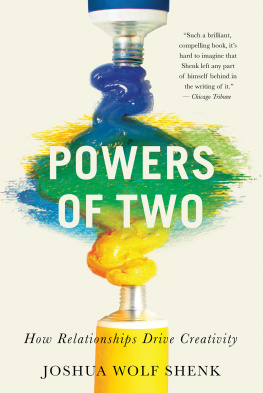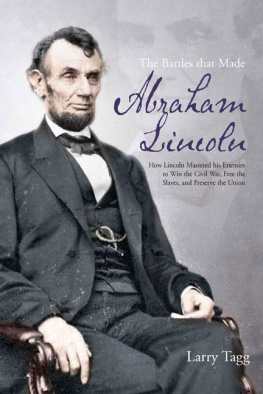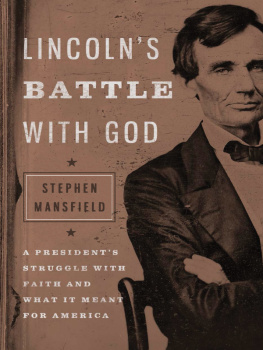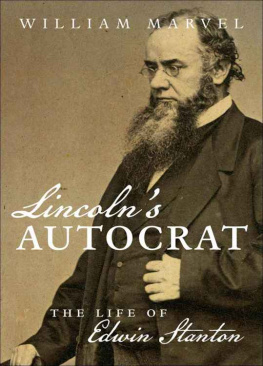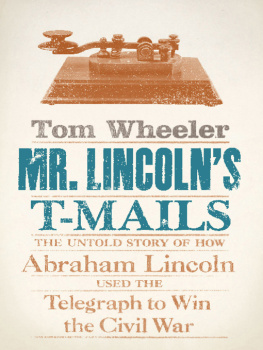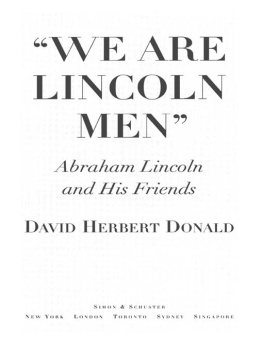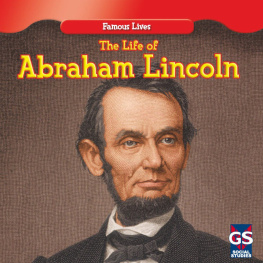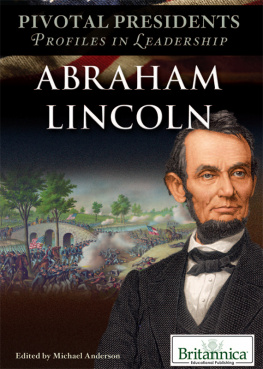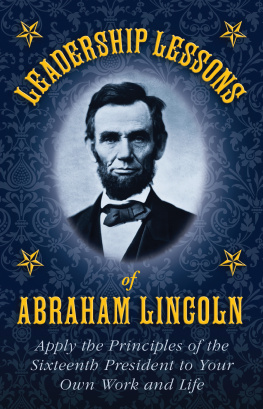ABRAHAM LINCOLN
Abraham Lincoln
A Life
VOLUME ONE
Michael Burlingame

2008 The Johns Hopkins University Press
All rights reserved. Published 2008
Printed in the United States of America on acid-free paper
Johns Hopkins Paperback edition, 2013
9 8 7 6 5 4 3 2 1
The Johns Hopkins University Press
2715 North Charles Street
Baltimore, Maryland 21218-4363
www.press.jhu.edu
The Library of Congress has cataloged the hardcover edition of this book as follows:
Burlingame, Michael, 1941
Abraham Lincoln : a life / Michael Burlingame.
p. cm.
Includes bibliographical references and index.
ISBN-13: 978-0-8018-8993-6 (hardcover: alk. paper)
ISBN-10: 0-8018-8993-6 (hardcover: alk. paper)
1. Lincoln, Abraham, 18091865. 2. PresidentsUnited StatesBiography. I. Title
E457.B95 2008
973.7092dc22
[B] 2007052919
A catalog record for this book is available from the British Library.
ISBN-13: 978-1-4214-0973-3
ISBN-10: 1-4214-0973-9
Special discounts are available for bulk purchases of this book. For more information, please contact Special Sales at 410-516-6936 or specialsales@press.jhu.edu.
The Johns Hopkins University Press uses environmentally friendly book materials, including recycled text paper that is composed of at least 30 percent post-consumer waste, whenever possible.
For Lewis E. Lehrman, Lincolnian extraordinaire
AUTHORS NOTE
Sixteenth president of the United States, the Great Emancipator, and an eloquent spokesman for Union, freedom, and democracy, Abraham Lincoln is one of the most studied and beloved of all Americans. This biography, the first comprehensive one to appear in two-thirds of a century, builds on a foundation of abundant fresh materialssome recently unearthed, others drawn from more traditional sources that historians have underutilized. It offers new interpretations, connecting Lincolns private and public lives, and incorporates the findings of countless excellent scholarly works on nineteenth-century America published since the appearance of the only comparable multi-volume biography, Carl Sandburgs Abraham Lincoln: The Prairie Years (two volumes, 1926), and Abraham Lincoln: The War Years (four volumes, 1939). Unlike the ten-volume life-and-times biography of Lincoln that his White House secretaries John G. Nicolay and John Hay published in 1890, this work does not attempt to relate the history of the Civil War. The focus here remains Lincoln himself. Telling the story of Lincolns life in detail, this narrative aims to avoid a problem that the eminent Civil War historian Allan Nevins identified. Heavy compression, he warned, could leave a biography of Lincoln pemmicanizednutritious but flavorless.
The year after Carl Sandburgs Abraham Lincoln: The War Years appeared, he penned a letter that resonates with me. In response to a critic who faulted those volumes for their analytical shallowness, use of dubious sources, lack of documentation, and many factual errors, he wrote of his amazement that the book got born, considering that many days when completely exhausted I despaired of ever bringing it through in accordance with the original design. By the time he finished, he said, he had spent some $11,000 on the project, was near a physical wreck, and believed the book would only slowly and across a long future make its way to the audience for whom it was intended.
While I can identify with the sentiments expressed in Sandburgs letter, my approach to Lincoln differs from his. Sandburg was a poet, I am a scholar. Our treatment of the famous letter of condolence to the Widow Bixby, written in 1864, vividly illustrates the difference between those two sensibilities. With a striking command of language, Sandburg described the document thus: [T]hese were blood-color syllables of a sacred music. I could never craft such a memorable sentence. As a scholar, I was more interested in a question Sandburg skipped over: Did Lincoln actually write the Bixby letter? The answer, as I have tried to show, based on stylistic grounds and on documentary evidence, is No. John Hay, Lincolns gifted assistant personal secretary, composed it for the presidents signature.
Sandburgs biography is long on elegant touches but short on research in unpublished sources. As a result, his biography compares to mine as John Constables full-size sketches of his 6-foot paintings of English country life compare with the finished canvasses. The subjectspeople, horses, cottages, rivers, rainbows, churches, and the likeare all visible in Constables sketches. But they lack the color, detail, and vividness of the finished worksthough both are of the same size. I hope that readers will conclude that this biography, with its fresh information, is more like Constables finished paintings, offering a portrait of Lincoln in higher resolution and sharper focus, with greater color, texture, and detail.
This biography relies on many sources simply unavailable to Sandburg and others, including the Lincoln Papers at the Library of Congress, which were first opened to public inspection in 1947. Access to that rich collection of 18,000 documents rendered all previous Lincoln biographies obsolete. Manuscript collections of Lincolns contemporaries have proven exceptionally revealing. In letters, diaries, journals, reminiscences, and other unpublished writings one can glean much new evidence about Lincoln: people would speak with him and then describe their conversations in diaries or letters; they would also comment on him and his policies and doings. Discovering such references in unpublished manuscripts requires much panning of historical gravel; every now and then a nugget appears, and readers will find many of them throughout this book.
Newspapers are another badly neglected source of information about Lincoln. They especially illuminate his early political career, for they not only shed light on his legislative work and political campaigns; they also contain scores of anonymous and pseudonymous contributions, many apparently the handiwork of Lincoln himself. These are particularly helpful because few of his early speeches survive (shorthand reporting was unknown in the 1830s and 1840s).
Other sources of new information include the reminiscences of people who knew Lincoln. Historians tend to view such recollections with skepticism, for memories can dim with time. But the increasing respectability of oral history has changed many scholarly minds. We are fortunate to have the work of Lincolns law partner and biographer William H. Herndon, who gathered invaluable interview material during his research for a life of Lincoln. Herndon also corresponded with many of Lincolns friends, family members, colleagues, and neighbors, creating one of the first oral history collections in the country. Without it, we would have little knowledge of Lincolns early life. Also helpful are interviews that other early biographers, most notably John G. Nicolay and Ida M. Tarbell, conducted in the course of their own research. For decades after the presidents assassination, newspapers published recollections of Lincolns acquaintances. Clipping collections at various repositories as well as searchable on-line historical newspaper archives make those articles readily accessible.
In the year 2000, the Lincoln Legal Papers appeared, reproducing and indexing more than 100,000 documents and illuminating the 5,200 cases that Lincoln handled in two dozen years at the Illinois bar. Only since its appearance can we speak with any authority about Lincolns career as a lawyer.
Next page


